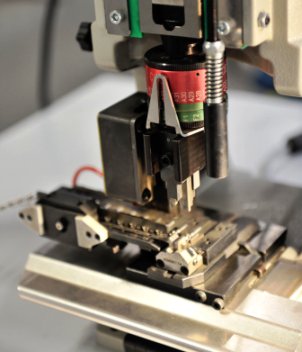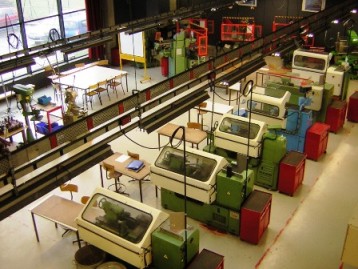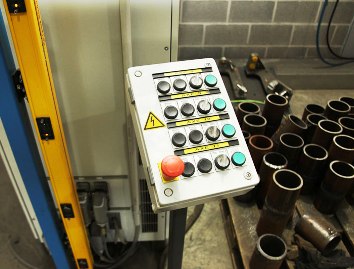Automated control systems for metal cutting machines
The electrical control systems of metal cutting machines are designed:
-
for carrying out the processes of acceleration, braking, speed regulation of electric motors, etc. (automatic control of electrical machines);
-
to perform control operations of machine drives — starting, establishing a sequence of movements, changing the direction of movement, etc. (automatic or semi-automatic operational control);
-
to protect machine parts and parts from damage, etc. (automatic technological protection).
In the process of the technological cycle of product processing, two modes of operation are generally used: the mode of setting operations and the mode of processing products (main).
In accordance with this, the electrical control scheme provides for the modes and elements of the main and adjusting control. In addition, many machines are provided with a setup management mode.
DO control the installation of metal cutting machines includes all control elements related to the installation and removal of the product, approach and withdrawal of the tool. Most of the setup operations require: performing slow or fast movements without changing the speed selected for the main control, and turning off the command pulse lock.
The transition from the main control to the tuning control can be done without additional switching (with a separate button control) or using a mode switch.
YES control of corrections includes the controls related to cutting the machine tool, with the movement of normally stationary machine units when switching to processing products of a different type, with the control of individual units, with changing or checking the program of the automatic processing cycle .
Unlike installation control operations, which are performed by the person working on the machine, adjustment operations are in most cases performed by the installer. Switching to adjustment mode can be done using adjustment switches located separately from the other controls.

Elementary functions of operational control and technological protection
The main functions of operational management include the following:
1) the choice of a moving body;
2) selection of operation mode or automatic cycle program;
3) the choice of the speed of movement;
4) choice of direction of movement;
5) launch;
6) stop.
The implementation of these functions is carried out with the help of controls in the process of control operations. A control operation can perform a single function or several functions in combination.
The grouping of functions in certain combinations determines the choice of control system, the design of control bodies and the structure of single-loop operational control schemes.
Ease of control is largely determined by the minimum number of controls for a given combination of functions for a trigger function and the minimum number of heterogeneous functions performed by each control.
On the other hand, to simplify the process of operational management and pillar chain different ways are used to combine control functions in one body. In case of inevitability of using two (or more) controls or electromagnetic devices, it is desirable to use separation of functions to simplify the schemes and structures.
Electrical control systems can perform the following functions of automatic technological protection of metal-cutting machines:
1) protection against breakage of machine parts in case of collision of moving elements (as a result of incorrect control operations or for other reasons);
2) protection of rubbing surfaces in case of insufficient lubrication or overheating (via remote temperature control);
3) protection of the tool from breakage with a sharp increase in cutting forces, as well as with a sudden stop of the main movement during feeding;
4) protection against rejection when stopped during processing.
The functions of technological protection can be performed by devices directly connected to this section of the circuit or by devices from interconnections.

Communications in electrical control systems
Distribution, amplification, multiplication, and transformation of electrical control commands are accomplished through direct control connections.
Locking of command pulses and control of command execution is carried out by feedback. The interaction of controls using these connections can be shown in the form of control block diagrams. The combination of serial connections of such a circuit is called a control channel.
Control flow charts are used for selection and synthesis as well as for explaining the control system.
Electrical control systems
From the point of view of the functional relationships between the elements in the chain, automatic control can be independent or dependent.
In independent control, the command to move to the next operation is sent from the final control element without feedback. Most of the elementary independent control schemes operate as a function of time.
Independent control systems differ from dependent control systems with fewer contacts and less machine wiring. But, on the other hand, in case of irregularities in the operation of the independent control scheme, there is often a discrepancy in the actions of the command and executive elements.
Dependent control systems are divided into two types:
1) closed;
2) with intermediate feedback.
A closed dependent control system is characterized by the fact that the command to move to the next operation, to stop or to continue working under changed conditions is given by the actuator (or motor) using feedback control after the processing of the previous command. Here's how feedback works:
1) from the traveled distance — with the help of road switches, pulse sensors, position sensors;
2) of speed — use speed relay or tachogenerator;
3) from the circulation of oil in the lubrication system — with the help of a reactive relay, etc.
In relay-contact control circuits, this dependence can be expressed in two signs - to cause interruption or inclusion of elements of the circuit. The advantage of closed control circuits is high accuracy, an almost complete guarantee of the sequence of action of the drives, since without the execution of the previous command there is no subsequent one.
The disadvantage of such schemes is the need to install appropriate machine equipment and branched machine cables. The intent to reduce hardware and wiring led to the use of intermediate circuit control circuits.
In these circuits, the command to proceed to the next operation is given by the elements of the control circuit: for example, the measurement of the speed of the DC drive is replaced by the measurement of e. etc. v. engine; oil circulation control (jet relay) is replaced by pressure measurement or pump activation control, etc.
The intent to reduce hardware and wiring led to the use of intermediate circuit control circuits.In these circuits, the command to proceed to the next operation is given by the elements of the control circuit: for example, the measurement of the speed of the DC drive is replaced by the measurement of e. etc. v. engine; oil circulation control (jet relay) is replaced by pressure measurement or pump activation control, etc.

